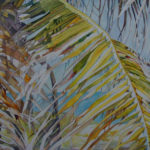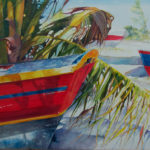Often when I’m teaching I see paintings in progress that have objects whether they are trees, flowers, dots, dashes, that are spaced evenly apart. I can take a ruler and show that the spacing is the same much to the surprise of the student. Please look at your spacing and create more of an asymmetrical setting of objects. I don’t know why we do that. It must be a mathematical brain thing.
Happy painting!




